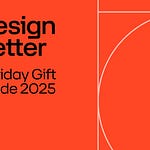Design systems are the foundation of nearly every piece of software we use. No one has had a greater influence on the philosophy and tactics of building design systems than Brad Frost, author of Atomic Design. After helping countless companies craft design systems, Brad has come to realize that this topic is a nexus of collaboration and conflict.
In our conversation, Brad shared why he thinks design systems are an enduring topic in design teams, the power of design tokens, and how AI is reshaping this space. Plus, Brad filled us in on his new online course on design tokens.
As a special opportunity for Design Better listeners, use code “DESIGNBETTERISAWESOME” at checkout for 20% off Brad’s upcoming design tokens course:
Bio
Brad Frost is a design system consultant, front-end developer, speaker, writer, musician, and artist located in beautiful Pittsburgh, PA. He helps teams establish and evolve design systems, establish more collaborative workflows, and create better software together. He is the author of the book Atomic Design, which introduces a methodology to create and maintain effective design systems. In addition to co-hosting the Style Guides Podcast, he has also helped create several tools and resources for web designers, including Pattern Lab, Styleguides.io, Style Guide Guide, This Is Responsive, Death to Bullshit, and more.
Premium Episodes on Design Better
This ad-supported episode is available to everyone. If you’d like to hear it ad-free, upgrade to our premium subscription, where you’ll get an additional 2 ad-free episodes per month (4 total). Premium subscribers also get access to the documentary Design Disruptors and our growing library of books, as well as our monthly AMAs with former guests, ad-free episodes, discounts and early access to workshops, and our monthly newsletter The Brief that compiles salient insights, quotes, readings, and creative processes uncovered in the show.
Visiting the links below is one of the best ways to support our show:
Masterclass: MasterClass is the only streaming platform where you can learn and grow with over 200+ of the world's best. People like Steph Curry, Paul Krugman, Malcolm Gladwell, Dianne Von Furstenberg, Margaret Atwood, Lavar Burton and so many more inspiring thinkers share their wisdom in a format that is easy to follow and can be streamed anywhere on a smartphone, computer, smart TV, or even in audio mode. MasterClass always has great offers during the holidays, sometimes up to as much as 50% off. Head over to http://masterclass.com/designbetter for the current offer.
Aquatru: We’d like to think our tap water is clean and healthy, but for so many there are impurities and chemicals that can be detrimental to our health. We’re big fans of AquaTru, makers of reverse osmosis filtration systems for your countertop or under sink. Get 20% OFF any AquaTru purifier at AquaTru.com with discount code DESIGNBETTER.
If you're interested in sponsoring the show, please contact us at:sponsors@thecuriositydepartment.com
If you'd like to submit a guest idea, please contact us at: contact@thecuriositydepartment.com
Insights from the episode
1. 🛠️ Design Systems as Storytelling Tools
Brad defines design systems in a unique way:
"A design system is the official story of how an organization designs and builds user interfaces."
He explains that this story has several components:
Assets (Figma libraries, code components, documentation)
People (teams, roles, relationships)
Process (workflows, governance, decision-making)
Rather than just being a collection of UI components, design systems are about orchestration of these elements to create coherent user experiences.
2. 🤝 The Fundamental Tension in Design Systems
Brad identifies a core tension that makes design systems an enduring challenge:
"It's really that balancing act of shared versus bespoke, and there's an innate tension there that will always be there."
This tension between standardization and customization, between efficiency and creativity, is why design systems remain a continuous journey rather than a solved problem.
3. 👥 Human Relationships at the Core
One of Brad's most powerful insights is that the real work of design systems is human-centered:
"It's ultimately the human relationships part of it that a lot of people don't care to admit is the real work of it... And it's like, y'all aren't talking to each other at all. That's your actual problem. You all need to talk to each other."
While teams often fixate on implementation details in Figma or code, the real challenges are often communication breakdowns between different disciplines.















